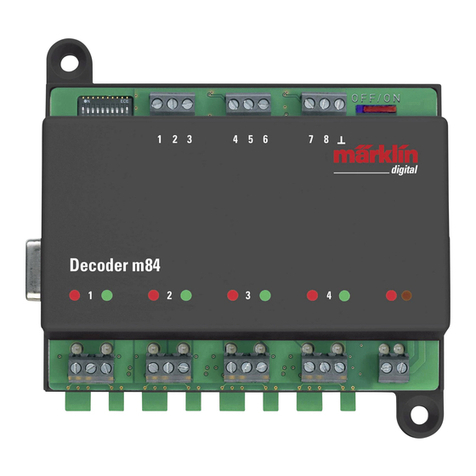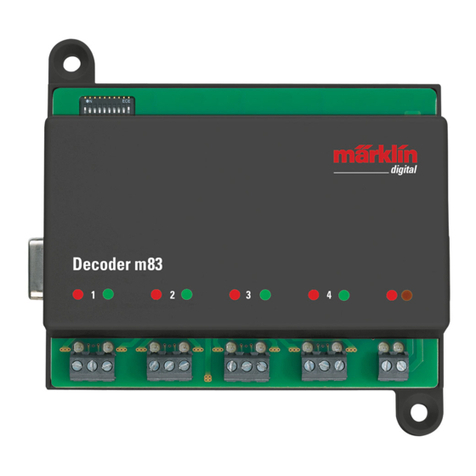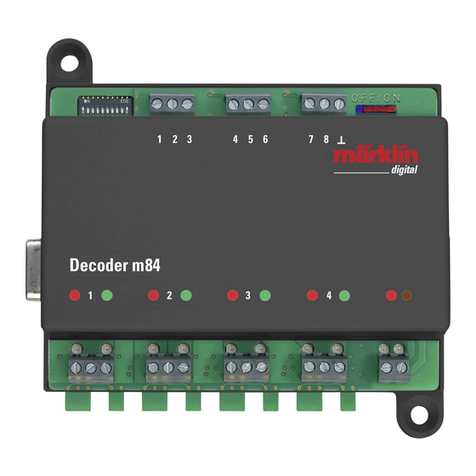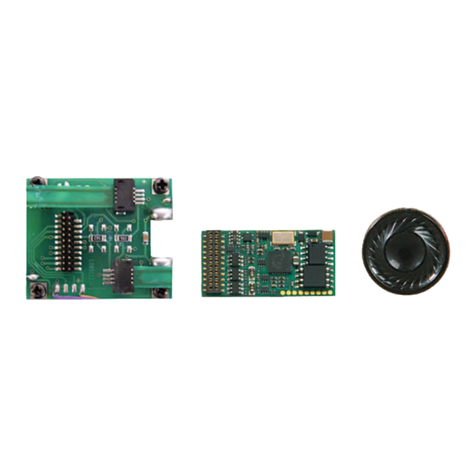
4
Funktionen
• Multiprotokollfähig (mfx, fx (MM), DCC und AC/DC).
• Automatische System-Erkennung.
• Anfahr- und Bremsverzögerung können getrennt vonei-
nander eingestellt werden.
• Programming on Main (PoM), diese Programmierung
muss vom Steuergerät unterstützt werden. Beachten Sie
hierzu die Bedienungsanleitung ihres Steuergerätes.
• Einstellbarer Rangiergang
• Brems- /Signalhalteabschnitt-Erkennung im Digitalbetrieb
• Der Decoder 60906 verfügt über keine Motorregelung.
• Verwendete Kabel-Farben nach Märklin-Standard
Der Decoder ist voll updatefähig. Voraussetzung hierfür
ist ein entsprechendes Steuergerät (Central Station 60213
– 60215, Software-Version 4.2.8, 60216 / 60226, Software-
Version 1.4.0).
Die Einstell- und Digitalfunktionen sind nur im Digitalbetrieb
anwendbar. Es stehen jedoch nicht in allen Protokollen die
gleichen Möglichkeiten zur Verfügung.
Hinweis: Im Analogbetrieb (DC) kann bei Lokomotiven bei
denen die Stirnbeleuchtung auf Masse geschaltet ist, bei
Vorwärtsfahrt das vordere Licht nicht leuchten (systembe-
dingt).
Decoder-Einbau
Vor dem Einbau ist die Lokomotive auf einwandfreie mecha-
nische und elektrische Funktion zu prüfen. Gegebenenfalls
muss die Lokomotive vor dem Umbau repariert werden. Für
Schäden durch nicht fachgerechte Arbeiten können wir
keine Garantie gewähren.
• Lok nach Angaben der Bedienungsanleitung öffnen
• mechanischen Fahrtrichtungsumschalter aus der Lok
ausbauen. Die Kabelverbindungen am Motor lösen.
• Die dem Decoder beiliegende Halteplatte an dem Pfosten
anschrauben, an dem der Fahrtrichtungsumschalter
befestigt war. Zum Schutz des Decoders empfehlen wir,
die Schraube mit einem Isolierband abzudecken.
• Die Kabel des Decoders soweit benötigt entsprechend
den Schaltbildern auf Seite 2 oder Seite 39 anlöten.
Hinweis: Die orangen Anschlüsse sind gleichwertig.
Verbraucher, die gegen Masse geschaltet sind (z.B. Rauch)
müssen immer gegen „Braun“ angeschlossen werden
(Masserückführung über den Rahmen / Chassis).
Verbraucher, die nicht gegen Masse angeschlossen sind
(z.B. Telex) dürfen nicht gegen „Braun“ sondern nur gegen
„Orange“ angeschlossen werden.
Das Violette Kabel dient als „Elektronik-Masse“, z.B. für
einen Pufferkondensator.
• Den Decoder in die Halteplatte einklipsen.
• Prüfen, ob alle Kabelverbindungen stabil sind und dass
keine ungewollten Verbindungen bestehen (Kurzschluss).
Achten Sie darauf, dass sich bei Fahrbetrieb keine Kurz-
schlüsse einstellen können.
• Lok in Betrieb nehmen und prüfen, evtl. Fehler beheben.
Wenn die Fahrtrichtung der Lok nicht der Fahrtrichtungen
des Steuergeräts entsprechen reicht es, das grüne und
das blaue Kabel am Motor zu tauschen.
• Lok wieder zusammenbauen.
































